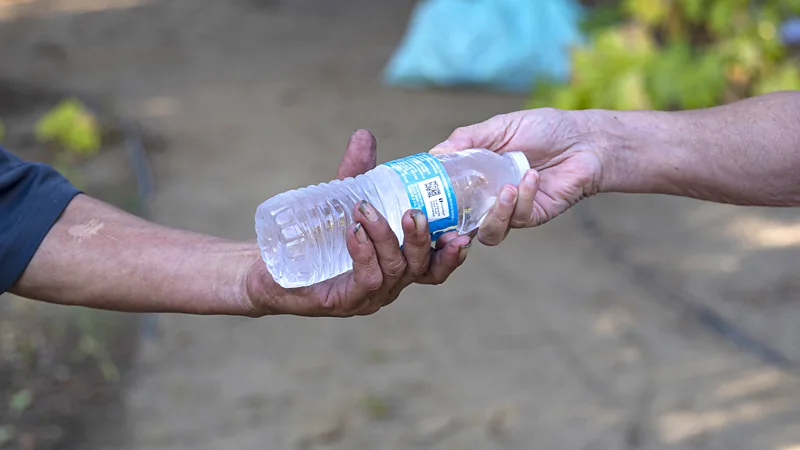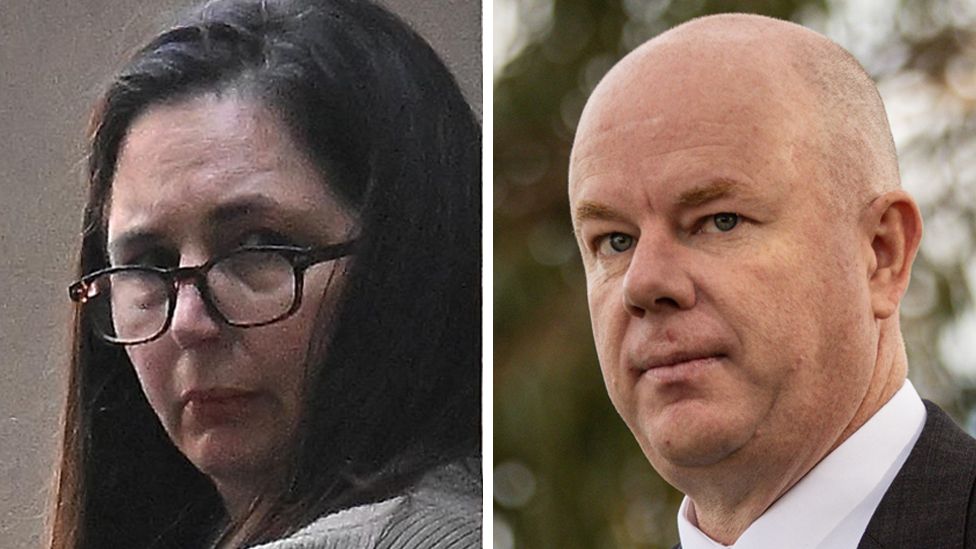Third-degree burns from the pavement: The reality of being homeless in a heatwave
IV drips, cooling centres and gallons of free water are just some of the tactics used to help the homeless survive deadly heat.

It's 82F (28C) in Koreatown, Los Angeles, and there's a light breeze – a relief from the triple digit (38C and up) temperatures the neighbourhood can reach during summer. But still, members of the homeless community are unusually lethargic as Ktown for All, a nonprofit delivering aid to unhoused individuals, makes their rounds. Volunteers hand out meals, hygiene packs, bottles of water and the odd tent to people sleeping on the streets, as well as checking in to see how they're coping with the heat.
An elderly man named Francis is seeking shelter at a bus stop, his belongings piled up high on the bench. He accepts the water, the wipes and food, and confirms he's managing to stay cool. He's usually chatty and loves to talk, but today he's quiet, and gives one-word answers.
People who end up falling asleep on the on the sidewalk can get second and third-degree burn from just how hot the pavements become – William Ellert
"A big part of what we do is trying to build relationships within our community and let people feel seen and heard," says Sherin Varghese, a lawyer during the week and head of outreach for Ktown for All during her weekends and evenings. "But when the weather gets hot, folks really aren't going to spend as much time talking because they're trying to conserve their energy."
"People are always very grateful for the water, because they're having a much rougher time," she continues. "They're trying to find shade, trying to stay inside somewhere, trying to find padding because the sidewalk can get incredibly hot, and can even cause burns."
The volunteers visit eight routes around Koreatown, which they traverse three Saturdays a month handing out food, water, sanitary supplies and any other useful items that have been donated. They've even begun handing out socks so people can insulate their feet and prevent them from getting burned.
An estimated 46,260 homeless people live in the city of LA alone – and numbers have been rising in recent years. Homelessness is, of course, an issue all year round, but it becomes particularly pressing during extreme weather – such as heat, or intense rainfall. Homeless people are many times more likely to die from heat, according to experts, and they are also more likely to experience ongoing health complications following heatstroke.
Water can be hard to come by for those living on the street, says Verghese. And this is especially problematic in the heat. "I've had people tell me how they walk half a mile to a grocery store that has a water dispenser, and then walk half a mile back with a five-gallon [19-litre] jug of water because there aren't enough services to fill that water-need gap."
In the summer, her team tries to hand out as many frozen water bottles as they can. "We're just trying to get water directly to people because even when there's accessible water it's often not potable. You have people trying to drink from fire hydrants or faucets that are outside of buildings. And it really comes down to: if you're unhoused, are you going to use your limited resources to try and access water?"
Anabel, 38, has lived on the streets for four years, after she lost her job during the pandemic. She has made the area around West Hollywood her home. But the urban heat island effect can have a significant impact on how hot the area gets on summer days – and nights. Anabel has a shopping trolley full of her belongings, and a temporary structure constructed from cardboard and tarpaulin, which she says gets extremely hot.
"It's really hard to stay cool," she says. "Because this tarpaulin blocks out any breeze and you kind of just bake inside, even though it's shaded from the Sun." It's also harder to get enough water to drink in the summer months, she says. "I just feel thirstier when it's hot, so I need more water, but getting hold of water can take up my entire day."
The number of extreme heat days in LA is predicted to rise, and Los Angelenos will experience three times more 95F (35C) days by 2041. According to an investigation by the LA Times in 2023, homeless people accounted for nearly half of heat-related deaths in LA county in 2022, despite making up just 70,000 of the county's 9.8 million residents.
The city has a network of cooling centres, which include libraries, parks and sports halls.
But Varghese says they can often be difficult to get to, and there's a lack of resources for homeless individuals, especially in the heat. "There's this false narrative that if we address the ability for people to wash their hands after using the bathroom, or being able to access drinking water, that this is somehow going to enable homelessness. That it's going to take away from resources that go towards getting people into shelters.
"And that's what I find so frustrating," she adds. "Instead of making sure they survive long enough to be able to access housing if and when it appears, they're making this trade off." (LA's homeless services authority did not respond to requests for comment.)
The struggles the unhoused population in LA is facing are not unique, and across America non-profits like Varghese's are finding new ways to help the homeless community cope with extreme weather.
In Maricopa County, Arizona, 645 people died of heat-related causes in 2023. At least 45% of those deaths were people experiencing homelessness. Maricopa is home to Phoenix, Arizona's biggest city, where the number of unsheltered homeless individuals has risen 64% in the past few years.
"Our heat has gotten up to 118F (48C)," says William Ellert, chief medical officer of Circle the City, a non-profit providing medical assistance to the homeless. "So you can imagine the effect that has."
Ellert's team, which provides around 54,000 medical encounters to roughly 8,000 people a year, regularly sees members of the unhoused community suffering from heat exhaustion, heat stroke – and even severe burns. "You know people who end up falling asleep on the on the sidewalk can get second and third-degree burn from just how hot the pavements become," he says. "We probably have about four months out of the year that extreme heat affects our homeless population."
This year, Ellert's team has been trying an unusual new attempt at treating heat exhaustion before it develops into heat stroke – which Ellert says often results in hospitalisation, or in the worst cases, can be deadly. "We saw the number of deaths that occurred last year and we said, 'We've got to do something more.'"
And so the team of doctors have been administering IVs to their unhoused patients. "In the past 45 days, we've administered about 70 of them, and we're fairly convinced it kept people out of hospital."
It can be life-saving, he says. "If we can rehydrate them, then we can avoid hospitalisation, or them progressing to heat stroke. Because by the time you end up with that, you can't really control your body temperature any more. So we believe by administering these IVs, we've been able to keep people from emergency rooms and potentially from death."
Ellert believes his team is the only group in Arizona administering IVs in this manner, but they are collaborating with other non-profits to spread the word.
Circle the City has five clinics across Phoenix and two teams of part-time doctors who administer what Ellert calls "street medicine" to the homeless in their spare time. "Our doctors go to the encampments because, for a lot of people, that's where all of their belongings are. If they come to a clinic their belongings could be stolen or thrown out when encampments are cleared out." (Phoenix City Council did not respond to a request for comment by the time this article was published.)
The organisation also has a "navigator" who goes into hospitals to help facilitate aftercare when homeless individuals are discharged. "The navigators are able to embed themselves in the hospitals and help the medical team with a safe discharge for the patient," Ellert explains. "We've kind of become the expert in homeless medicine."
Ellert says aftercare for homeless individuals who have been treated in hospitals is especially difficult during hot days. Sores, abscesses and infections can develop easily when you're living on the street.
It's something Varghese has noticed, too. "Other health issues get exacerbated; infection spreads faster in the heat. It's hard to keep wounds clean because water is so hard to come by.
"We've had more people asking for medical supplies, and insulin is a big one because it's supposed to stay refrigerated which is a huge struggle. And we don't have a good solution for that."
It's a big problem, says Varghese, but there are small things that individuals can do to help. "The little things aren't answers to systemic problems, but if you're capable of buying a case of water, putting it in your freezer and carrying a few with you when you go for a walk – or even taking out ice pops – you could really help someone [by giving them] a cold water on a hot day."
-BBC







